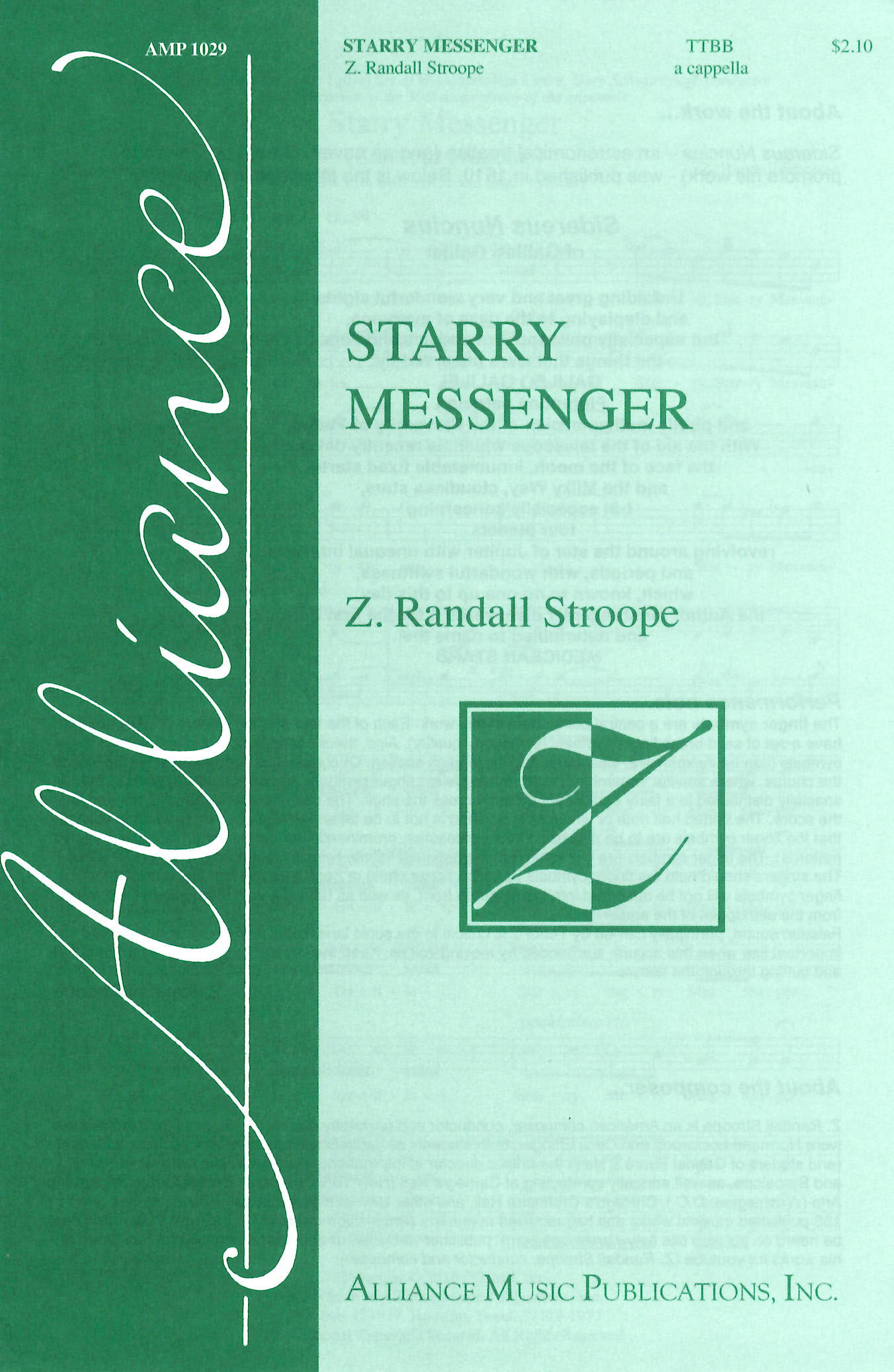Composed by
Z. Randall Stroope
Voicing: TTBB
Instrumentation: tambourine and finger cymbal
Catalog number: AMP 1029
Price: $2.10

About the work...
Sidereus Nuncius – an astronomical treatise (and an advertisement by Galileo to promote his work) - was published in 1610. Below is the title page in translation:
Sidereus Nuncius
of Galileo Galilei
Unfolding great and very wonderful sights
and displaying to the gaze of everyone,
but especially philosophers and astronomers,
the things that were observed by
GALILEO GALILEI,
Florentine patrician
and public mathematician of the University of Padua,
With the aid of the telescope which he recently devised,
the face of the moon, innumerable fixed stars,
and the Milky Way, cloudless stars,
but especially concerning
four planets
revolving around the star of Jupiter with unequal intervals
and periods, with wonderful swiftness,
which, known to no one up to this day,
the Author most recently discovered it for the first time,
and determined to name the
MEDICEAN STARS
Performance note...
The finger cymbals are a central component of this work. Each of the four section leaders (TTBB) need to
have a set of solid brass finger cymbals (symphony quality). Also, there needs to be another 4 sets of finger
cymbals (can be inexpensive, classroom quality) in each section. Of course, this is dependent on the size of
the chorus, where smaller ensembles might employ fewer finger cymbals. All finger cymbals need to be
specially distributed in a fairly equidistant pattern across the choir. The use of finger cymbals is notated in
the score. The dotted half note or whole note notation is not to be taken literally, but simply as an indication
that the finger cymbals are to be played on those measures, prominently and randomly (in multiple rhythmic
patterns). The finger cymbals are the sonic representation of infinite twinkling stars across a vast universe.
The singers should hold the finger cymbals up to the upper chest or neck level, so that the sound of the
finger cymbals will not be absorbed into the singer in front, as well as having a very interesting visual effect
from the standpoint of the audience.
Falsetto sound, principally carried by Tenor 2 is critical to the sonic landscape, and is arguably the more
important line when this occurs, surrounded by moving voices. Keep the falsetto bright, ringing (not breathy),
and cutting through the texture.
Z. Randall Stroope
About the composer...
Z. Randall Stroope is an American composer, conductor and university professor. www.zrstroope.com His composition teachers
were Normand Lockwood and Cecil Effinger, both students of Nadia Boulanger, the famous French teacher
(and student of Gabriel Faure.) He is the artistic director of international summer music festivals in Rome
and Barcelona, as well annually conducting at Carnegie Hall (New York), Kennedy Center for the Performing
Arts (Washington, D.C.), Chicago's Orchestra Hall, and other U.S. and international venues. He has over
180 published musical works and has received numerous composition awards. Recordings of his music can
be heard on his web site www.zrstroope.com , publisher websites, or definitive recordings he has made of
his works for youtube (Z. Randall Stroope, conductor and composer).
About Galileo
Galileo Galilei was born in Pisa (then part of the Duchy of Florence, Italy) on 15
February 1564. His father was a famous lute player, theorist and composer. After
considering the vocation of priesthood, Galileo decided to enroll at the University of Pisa
for a medical degree. Yet, early in his studies, he chose instead to concentrate on
mathematics and natural philosophy. He invented the thermoscope (forerunner of the
thermometer), and at just 18 years of age, published a small book on the design of a
hydrostatic balance. Eventually, he became the chair of mathematics in Pisa when he
was 27. Galileo was an avid inventor, philosopher, mathematician and astronomer. As
such, he was destined to become at odds with the church that believed that the universe
to be geocentric (revolved around the earth.) Galileo firmly believed that the universe -
including the earth - revolved around the sun.
One of Galileo's inventions was the telescope. It magnified objects 20 times, allowing
him to look at the moon, discover four satellites of Jupiter, verify the phases of Venus,
discover sunspots and observe a supernova. In 1610 he wrote an astronomical treatise
based on observations he made with his telescope, entitled Sidereus Nuncius (transl.
“Starry Messenger” or “Starry Message”) which is the basis for the text of this musical
work.
Z. Randall Stroope
Click
here to hear a recording. (MP4)
Click here to see a sample.



